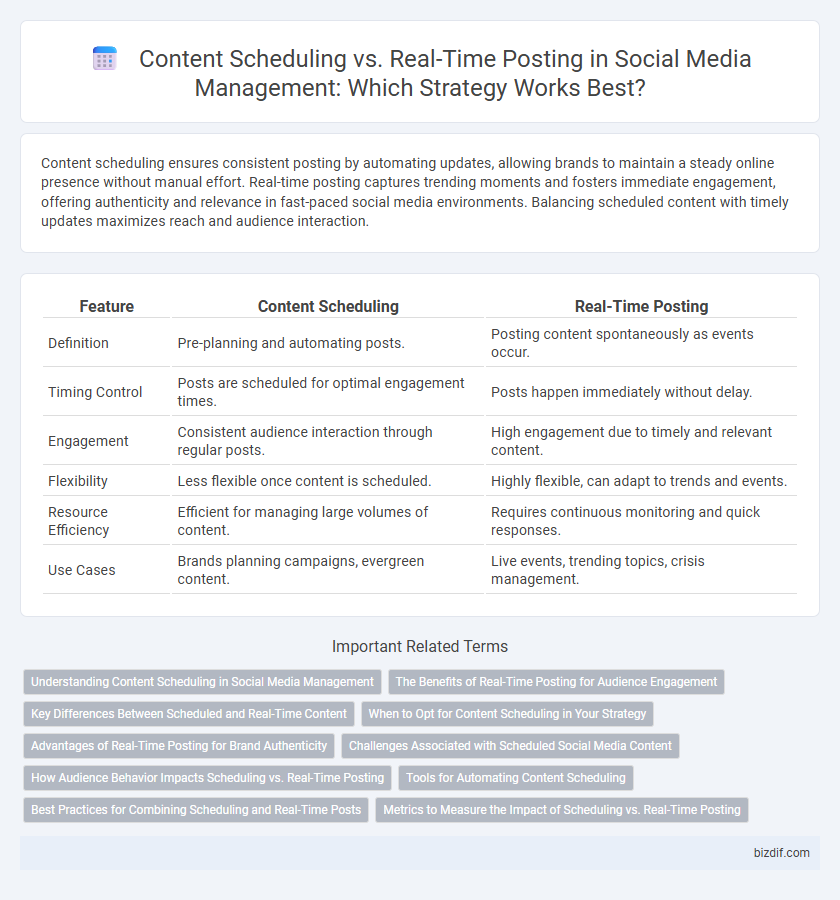Content scheduling ensures consistent posting by automating updates, allowing brands to maintain a steady online presence without manual effort. Real-time posting captures trending moments and fosters immediate engagement, offering authenticity and relevance in fast-paced social media environments. Balancing scheduled content with timely updates maximizes reach and audience interaction.
Table of Comparison
| Feature | Content Scheduling | Real-Time Posting |
|---|---|---|
| Definition | Pre-planning and automating posts. | Posting content spontaneously as events occur. |
| Timing Control | Posts are scheduled for optimal engagement times. | Posts happen immediately without delay. |
| Engagement | Consistent audience interaction through regular posts. | High engagement due to timely and relevant content. |
| Flexibility | Less flexible once content is scheduled. | Highly flexible, can adapt to trends and events. |
| Resource Efficiency | Efficient for managing large volumes of content. | Requires continuous monitoring and quick responses. |
| Use Cases | Brands planning campaigns, evergreen content. | Live events, trending topics, crisis management. |
Understanding Content Scheduling in Social Media Management
Content scheduling in social media management enables brands to plan and automate posts across multiple platforms, ensuring consistent audience engagement without manual intervention. This strategic approach leverages analytics to optimize posting times, improve reach, and maintain a steady content flow aligned with marketing goals. By contrast, real-time posting responds to immediate events but lacks the predictability and efficiency that scheduling provides for long-term campaign success.
The Benefits of Real-Time Posting for Audience Engagement
Real-time posting enables immediate interaction and responsiveness, enhancing audience engagement by capitalizing on trending topics and current events. This approach fosters authentic connections and drives higher visibility through timely content that resonates with followers' interests. Instant feedback and conversations generated by real-time posts boost social media algorithms, increasing reach and overall engagement rates.
Key Differences Between Scheduled and Real-Time Content
Content scheduling allows marketers to plan and automate posts for optimal times, ensuring consistent engagement and efficient workflow across platforms like Facebook, Instagram, and Twitter. Real-time posting focuses on immediate content delivery, fostering timely interaction and responsiveness during events or trending moments. The key difference lies in the balance between strategic timing with scheduled posts and enhanced relevance and spontaneity with real-time updates.
When to Opt for Content Scheduling in Your Strategy
Content scheduling is ideal for brands aiming to maintain a consistent posting frequency, especially when targeting multiple time zones or planning campaigns in advance. Using tools like Hootsuite or Buffer allows marketers to automate posts, ensuring optimal engagement during peak hours without manual intervention. This strategy proves effective for businesses managing high volumes of content, reducing the risk of missed posts and enabling data-driven adjustments based on scheduled performance analytics.
Advantages of Real-Time Posting for Brand Authenticity
Real-time posting enhances brand authenticity by delivering timely and relevant content that resonates with current events and audience sentiments. It fosters genuine engagement and strengthens trust by showcasing the brand's responsiveness and personality in the moment. This immediacy boosts social algorithms, increasing visibility and organic reach across platforms like Instagram, Twitter, and Facebook.
Challenges Associated with Scheduled Social Media Content
Scheduled social media content often faces challenges such as reduced engagement due to lack of timely interaction and the inability to respond to real-time events or trending topics, which can diminish audience relevance. Algorithms on platforms like Instagram and Twitter prioritize fresh, immediate content, causing pre-scheduled posts to receive lower visibility compared to real-time updates. Moreover, rigid scheduling can lead to missed opportunities for personalized engagement and rapid crisis management, essential for maintaining brand credibility.
How Audience Behavior Impacts Scheduling vs. Real-Time Posting
Audience behavior significantly influences the effectiveness of content scheduling versus real-time posting on social media platforms. Scheduled posts allow brands to target peak engagement times based on audience activity patterns, ensuring consistent visibility and reach. However, real-time posting leverages spontaneous interactions and trending moments, capitalizing on immediate audience responsiveness to enhance relevance and engagement.
Tools for Automating Content Scheduling
Content scheduling tools like Hootsuite, Buffer, and Sprout Social automate the posting process by organizing and publishing content at optimal times to maximize engagement. These platforms offer features such as calendar views, bulk uploads, and performance analytics, streamlining social media management and ensuring consistent brand presence. Real-time posting remains important for timely interactions, but automation tools enhance efficiency and allow marketers to plan content strategically across multiple channels.
Best Practices for Combining Scheduling and Real-Time Posts
Effective social media management balances content scheduling with real-time posting by leveraging analytics to identify peak engagement times while staying responsive to current trends and audience interactions. Tools like Hootsuite and Buffer enable precise scheduling that maintains brand consistency, whereas monitoring live conversations allows for timely, authentic posts that boost relevance. Integrating both strategies maximizes reach and fosters active community engagement, driving stronger audience connection and improved platform performance.
Metrics to Measure the Impact of Scheduling vs. Real-Time Posting
Content scheduling enables consistent posting frequency, improving audience reach metrics such as engagement rate and post impressions by aligning with peak activity times. Real-time posting captures immediate trends, often resulting in higher interaction rates and faster response times, measurable through metrics like click-through rate and conversion rate. Comparing metrics like follower growth, engagement velocity, and reach provides insight into the effectiveness of scheduling versus real-time strategies for social media management.
Content scheduling vs Real-time posting Infographic

 bizdif.com
bizdif.com